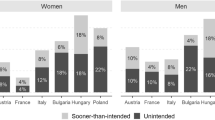Abstract
Introduction Recent efforts show potential to advance research on unintended childbearing by taking a couple-level approach. However, this work has neither adequately addressed methodological concerns stemming from the challenges associated with male fertility data nor considered the viability of women’s proxy reports of fathers intentions. Methods Data from the Early Childhood Longitudinal Study, Birth Cohort (ECLS-B) were used to assess the implications of low response rates among men on couples’ unintended childbearing. Then, the accuracy of women’s proxy reports of fathers intentions was assessed. Weighted logistic regression analyses were conducted to determine how women’s characteristics were associated with men’s survey participation whereas weighted multinomial logistic regression analyses were applied to determine how women’s characteristics were linked with the accuracy of her proxy report. Results Almost half (46%) of women cannot be matched with data from the child’s father, and this discrepancy is most problematic for women who are black, foreign-born, less educated, and unmarried at birth. Women’s proxy reports appear viable as 75% of women’s reports are consistent with men’s responses. Yet, proxy reports underestimate disagreement in couples’ intentions as mothers who intended the birth are at an increased risk of “inaccurately” reporting that fathers share their intentions. Discussion Direct approaches to couples’ intentions yield privileged samples and systematically omit women at the greatest risk of an unintended birth. However, proxies underestimate disagreement in couples’ intentions—a key contribution to the couple approach. Accordingly each approach has its own merits which must be considered in light of specified research questions.
Similar content being viewed by others
References
Barber, J. S., Axinn, W. G., & Thornton, A. (1999). Unwanted childbearing, health, and mother-child relationships. Journal of Health and Social Behavior, 40(3), 231–257.
Barber, J. S., & East, P. L. (2009). Home and parenting resources available to siblings depending on their birth intention status. Child Development, 80(3), 921–939.
Beckman, L. J., Aizenberg, R., Forsythe, A. B., & Day, T. (1983). A theoretical analysis of antecedent’s of young couples’ fertility decisions and outcomes. Demography, 20(4), 519–533.
Finer, L. B., & Henshaw, S. K. (2006). Disparities in rates of unintended pregnancy in the United States, 1994 and 2001. Perspectives on Sexual and Reproductive Health, 38(2), 90–96.
Finer, L. B., & Zolna, M. R. (2011). Unintended pregnancy in the United States: Incidence and disparities. 2006. Contraception, 84(5), 478–485.
Fried, E. S., & Udry, J. R. (1979). Wives’ and husbands’ expected costs and benefits of childbearing as predictors of pregnancy. Biodemography and Social Biology, 26(4), 265–274.
Goldscheider, F. K., & Kaufman, G. (1996). Fertility and commitment: Bringing men back in. Population and Development Review, 22, 87–99.
Greene, M. E., & Biddlecom, A. E. (2000). Absent and problematic men: Demographic accounts of male reproductive roles. Population and Development Review, 26(1), 81–115.
Guzzo, K. B. (2017). Unintended Births: Variation across Social and Demographic Characteristics. Family Profiles, FP-17-09. Bowling Green, OH: National Center for Family and Marriage Research. https://www.bgsu.edu/ncfmr/resources/data/family-profiles/guzzo-unintended-births-variation-social-dem-char-fp-17-09.html.
Guzzo, K. B., & Hayford, S. (2011). Fertility following an unintended first birth. Demography, 48(4), 1493–1516.
Hohmann-Marriott, B. (2009). The couple context of pregnancy and its effects on prenatal care and birth outcomes. Maternal and Child Health Journal, 13(6), 745–754.
Korenmann, S., Kaestner, R., & Joyce, T. (2002). Consequences for infants of parental disagreement in pregnancy intention. Perspectives on Sexual and Reproductive Health, 34(3), 198–205.
Lindberg, L. D., & Kost, K. (2013). Exploring U.S. Men’s birth intentions. Maternal Child and Health Journal, 18(3), 625–633.
Martin, E. (2007). Strength of attachment: Survey coverage of people with tenuous ties to residences. Demography, 44(2), 427–440.
Martin, L. T., McNamara, M. J., Milot, A. S., Halle, T., & Hair, E. C. (2007). The effects of father involvement during pregnancy on receipt of prenatal care and maternal smoking. Maternal and Child Health Journal, 11(6), 595–602.
Miller, W. B., Sable, M. R., & Beckmeyer, J. J. (2009). Preconception motivation and pregnancy wantedness: Pathways to toddler attachment security. Journal of Marriage and Family, 71(5), 1174–1192.
Moore, K. A., Ryan, S., Manlove, J., Mincieli, L., & Schelar, E. (2009). High-risk subsequent births among co-residential couples: The role of fathers, mothers, and couples. Fathering, 7(1), pp. 91–102.
Morgan, S. P. (1985). Individual and couple intentions for more children: A research note. Demography, 22(1), 125–132.
Mosher, W. D., Jones, J., & Abma, J. C. (2012). Intended and unintended births in the United States: 1982–2010. National Health Statistics Report, p. 55.
Musick, K., England, P., Edginton, S., & Kangas, N. (2009). Education differences in intended and unintended fertility. Social Forces, 88(2), 543–572.
National Center for Education Statistics. (2004). User’s manual for the ECLS-B nine-month restricted-use data file and electronic codebook. Washington, DC.
Saleem, H. T., & Surkan, P. J. (2014). Parental pregnancy wantedness and child social-emotional development. Maternal and Child Health Journal, 18(4), 930–938.
Santelli, J. S., Rochat, R., Hatfield-Timajchy, K., Gilbert, B. C., Curtis, K., Cabral, R., Hirsch, J. S., & Schieve, L. (2003). The measurement and meaning of unintended pregnancy. Perspectives on Sexual and Reproductive Health, 35(2), 94–101.
Sorenson, E. (1997). A national profile of nonresident fathers and their ability to pay child support. Journal of Marriage & Family, 59(4), 785–797.
Stykes, J. B., Manning, W. D., & Brown, S. L. (2013). Nonresident fathers and formal child support: Evidence from the CPS, the NSFG, and the SIPP. Demographic Research, 29(46), 1299–1330.
Thomson, E. (1997). Couple childbearing, desires, intentions, and births. Demography, 34(3), 343–354.
Williams, L. B. (1994). Determinants of couple agreement in US fertility intentions. Family Planning Perspectives, 26(4), 169–174.
Author information
Authors and Affiliations
Corresponding author
Rights and permissions
About this article
Cite this article
Stykes, J.B. Methodological Considerations in Couples’ Fertility Intentions: Missing Men and the Viability of Women’s Proxy Reports. Matern Child Health J 22, 1164–1171 (2018). https://doi.org/10.1007/s10995-018-2501-6
Published:
Issue Date:
DOI: https://doi.org/10.1007/s10995-018-2501-6




